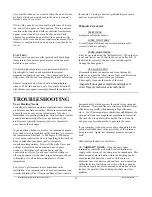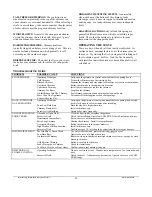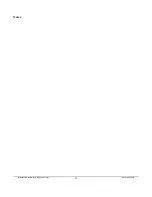
HearthStone
Quality Home Heating Products Inc
®
Starlet Model 8550
15
high firebox temperatures. In addition, the asbestos-free
furnace cement must be cured slowly to insure adequate
sealing and bonding.
The bottom layer of firebrick in your firebox is intended to
prevent thermal stress and should remain in place in the
firebox at all times. Do not use a grate to elevate the fire.
Build the wood fire directly on the hearth.
When you light your first fires, the wood stove will emit
some smoke and fumes. This is normal “off-gassing” of the
paints and oils used when manufacturing the wood stove. If
you find it necessary, open a few windows to vent your
room. The smoke and fumes will usually subside after 10
to 20 minutes of operation. The odor and smoke will end
once the stove is “cured”.
The first fires may produce other odors from impurities that
exist in the area immediately surrounding the stove. Some
of these impurities can be cleaning solvents, paint solvents,
cigarettes, smoke, pet hair, dust, adhesives, a new carpet,
and new textiles. These odors will dissipate over time.
You can alleviate these odors by opening a few windows or
otherwise creating additional ventilation around your stove.
If any odor persists, contact your dealer or an authorized
service technician.
If you adhere to the following break-in procedure, as well
as all other operating procedures in this manual, the cast
iron and stone components of your stove will give you
many years of trouble-free use. With use, the color of the
soapstone may change and small fractures may appear on
the surface of the stone. These changes will only add
character and distinction to your stove.
Avoid the following conditions that can cause the stone or
cast iron pieces to break:
•
Do not throw wood into the stove.
•
Do not use the doors as leverage to force wood into the
stove.
•
Do not load wood that is encrusted with ice into a
burning stove as the thermal shock can cause damage.
•
Do not use a manufactured grate. Burn the fire directly
on the firebrick that lines the bottom of the firebox.
B
REAK
I
N
F
IRE
1.
Open the door and place five or six double sheets
of tightly twisted newspaper in the center of the
firebox. Arrange kindling in a criss-cross pattern
over the newspaper. Kindling should be
approximately ten pieces, 1/2" (13 mm) in
diameter and 10" to 18" (254 mm to 457 mm)
long.
2.
Fully open the primary air control by pulling the
control handle fully forward.
3.
Light the paper under the kindling. Leave the
front door slightly ajar momentarily until the
kindling has started to burn and draft begins to
pull.
4.
Close the door and allow the fire to burn. Keep
the door closed while the stove is in use.
5.
KEEP A WATCHFUL EYE ON YOUR STOVE
to maintain a steady, low-heat fire. Your first and
subsequent break-in fires should make the stove
warm but not hot to the touch. At most, a few
small pieces of wood should be added to the fire
to reach safe break-in temperatures.
6.
Once the stove is warm but not hot to the touch
close the primary air control and allow the fire to
die out completely.
7.
Let the stove return to room temperature.
Your first three break-in fires should be built and
maintained as outlined above. Your patience will be
rewarded by a properly seasoned stove.
NOTE: Because of the cool flue gas temperatures present
during the break-in procedure, creosote may build up
quickly. We recommend a visual inspection (and cleaning
if necessary) of your stovepipe and chimney once the
break-in procedure is completed.
N
ORMAL
O
PERATION
If your stove is not used continuously or has not been used
in quite some time, follow the break-in procedure at least
once to minimize the stress of a hot fire on a cold stove
before proceeding with normal operation. We recommend
one break-in fire at the start of each heating season. Prior
to loading the stove, make sure the ashes have been
removed from the stove.
B
UILDING
A F
IRE
F
OR
E
VERYDAY
U
S E
1) Open the front or side door and place five or six
double sheets of tightly twisted newspaper in the
center of the firebox. Arrange kindling in a
crisscross pattern over the newspaper. Kindling
should be approximately ten pieces, 1/2" (13 mm)
in diameter and 10" to 18" (254 to 457 mm) long.
2) Fully open the primary air control by sliding it
forward
3) Light the paper under the kindling. Leave the
front door slightly ajar momentarily until the











































